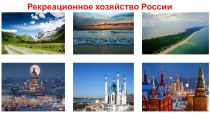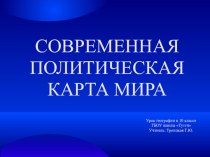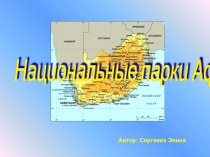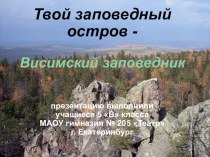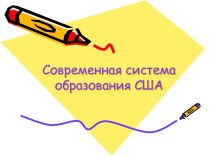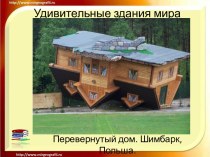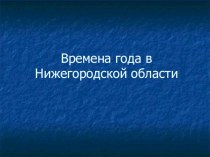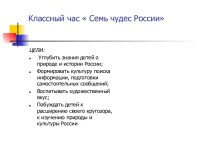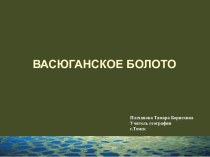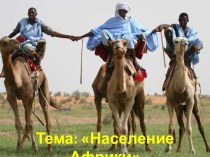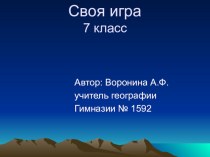- Главная
- Разное
- Бизнес и предпринимательство
- Образование
- Развлечения
- Государство
- Спорт
- Графика
- Культурология
- Еда и кулинария
- Лингвистика
- Религиоведение
- Черчение
- Физкультура
- ИЗО
- Психология
- Социология
- Английский язык
- Астрономия
- Алгебра
- Биология
- География
- Геометрия
- Детские презентации
- Информатика
- История
- Литература
- Маркетинг
- Математика
- Медицина
- Менеджмент
- Музыка
- МХК
- Немецкий язык
- ОБЖ
- Обществознание
- Окружающий мир
- Педагогика
- Русский язык
- Технология
- Физика
- Философия
- Химия
- Шаблоны, картинки для презентаций
- Экология
- Экономика
- Юриспруденция
Что такое findslide.org?
FindSlide.org - это сайт презентаций, докладов, шаблонов в формате PowerPoint.
Обратная связь
Email: Нажмите что бы посмотреть
Презентация на тему Egyptian Civilization
Содержание
- 3. The NILE RIVER , the longest river
- 4. Bounded on the south, east and west
- 5. For centuries, THE NILE RIVER FLOODED THE
- 6. TRANSPORTATION: The Nile River was the highway
- 7. DUALITIES, such as desert and river valley,
- 9. ARCHITECTURE: The ancient Egyptians built their pyramids,
- 10. Apart from the pyramids, EGYPTIAN BUILDINGS were
- 14. One of the oldest mysteries surrounding ancient
- 15. One theory suggests that RAMPS were used
- 16. Ramp on pyramid
- 17. Stone block on sled
- 18. Pouring water to lubricate the ramp
- 19. Rocking a block into position
- 20. THE WOODEN CRANE THEORY suggests that a
- 21. The pyramids were probably NOT BUILT BY
- 22. Pyramids did not stand alone; they were
- 24. GOVERNMENT and RELIGION were inseparable in ancient
- 25. The PHAROAH was at the top of
- 26. To reinforce their image as powerful divine
- 27. Not all the pharaohs were men. Before
- 28. ROYAL WOMEN: Royal mothers, wives, and daughters
- 29. Next to pharaoh, the most powerful officer
- 30. The ancient Egyptians remained very conscious of
- 32. The EGYPTIAN LANGUAGE was one of the
- 33. The word HIEROGLYPH literally means "sacred carvings".
- 34. The ancient language was written by SCRIBES
- 35. Be a scribe. It will save you
- 36. Papyrus PlantPapyrus SheetAnimation of paper-making processTo make
- 37. DRAFTSMEN were scribes who specialized in drawing.They
- 38. Sacred texts, known as the PYRAMID TEXTS,
- 39. COFFIN TEXTS emphasized the afterlife and helped
- 40. The JUDGMENT OF THE DEAD was a
- 41. The BOOK OF THE DEAD contains approximately
- 43. RELIGION is the glue that binds local
- 44. By looking at ancient Egypt, one can
- 45. As human society evolved, people gradually gained
- 46. At that stage, every Egyptian town had
- 47. Like all religions, that of ancient Egypt
- 48. PRIESTS worked at the temples, conducting the
- 49. Entering a Temple
- 52. The ancient Egyptians believed in the RESURRECTION
- 53. Around 450 B.C., the Greek historian HERODOTUS
- 54. NATRON, a disinfectant and dehydration agent, was
- 55. MATERIALS USED IN MUMMIFICATION: Linen Sawdust
- 56. MUMMIFICATION TOOLS:The ancient embalmers used very few
- 57. There are three elements to the Egyptian
- 58. The journey to the afterworld was considered
- 59. Here the gods of the dead performed
- 60. When a pharaoh passed the test, he
- 62. The flooding of the Nile rendered the
- 63. Breaking the ground with plow and
- 64. In mid-September, farmers blocked canals to retain
- 65. LIVESTOCK was important to the Egyptian economy,
- 66. Barley and emmer, were used to make
- 67. Grapes were processed into WINE for the
- 68. Pharaohs and nobles participated in HUNTING, FISHING
- 69. FISHING allowed the working class to add
- 70. Most HOUSES were made of BRICK. The
- 71. CRAFTWORKERS lived in one- or two-storey FLAT-ROOFED
- 72. The HOMES OF THE WEALTHY were larger
- 73. A villa from the city of Amarna
- 74. ROYAL PALACES, frequently CITIES IN THEMSELVES, included
- 75. SKILLED ARTISANS were considered SOCIALLY SUPERIOR to
- 76. WOMEN engaged in WEAVING, PERFUME MAKING, BAKING
- 77. FLAX grown by farmers was woven into
- 78. The Egyptian ELITE HIRED HAIRDRESSERS and took
- 79. Elite men and women enhanced their appearance
- 81. MATHEMATICS: Although the Egyptians lacked the symbol
- 82. ASTRONOMY: Like many ancient peoples, the Egyptians
- 83. MEDICINE: The doctors of ancient Egypt combined
- 84. Скачать презентацию
- 85. Похожие презентации

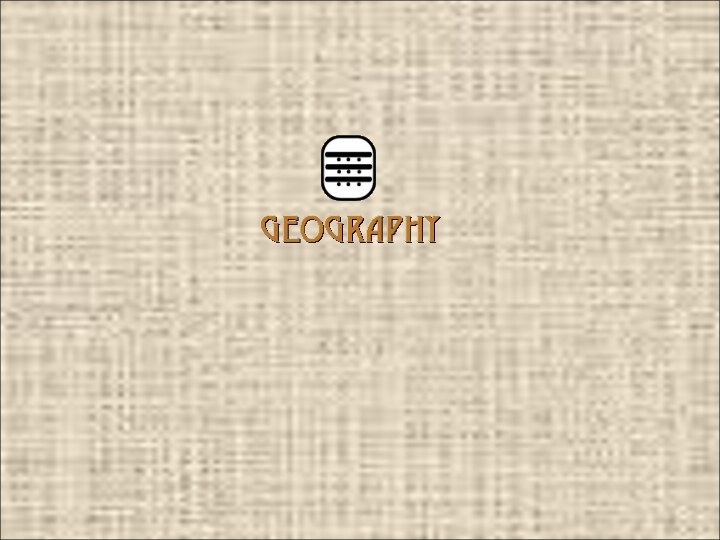


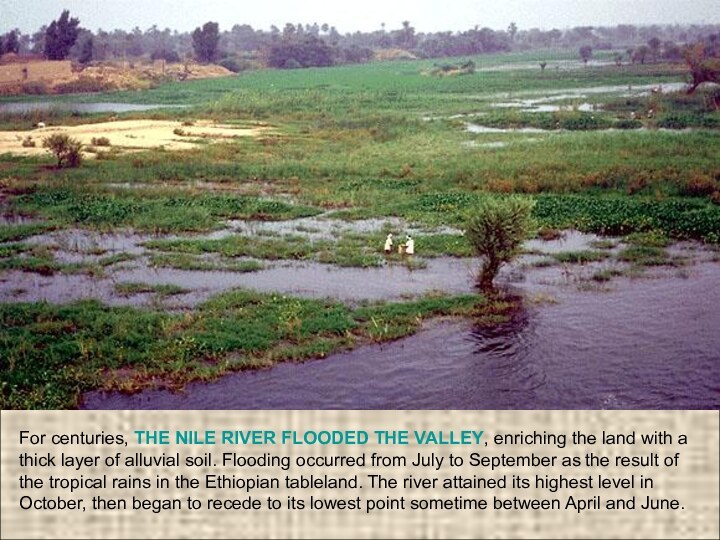

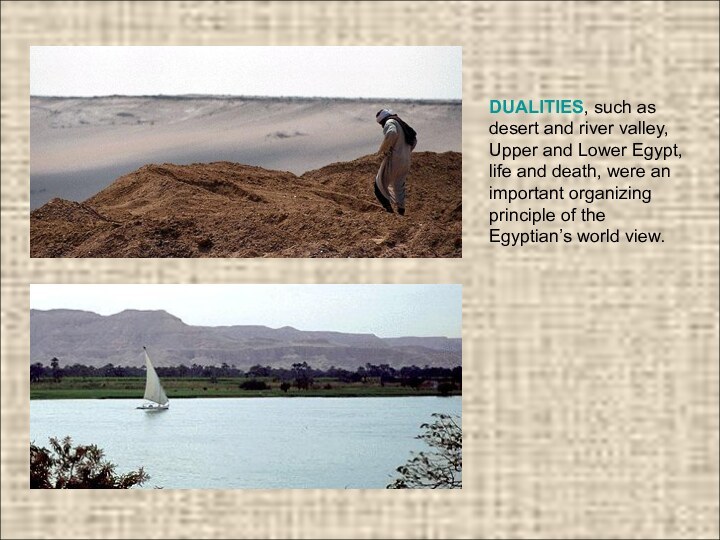

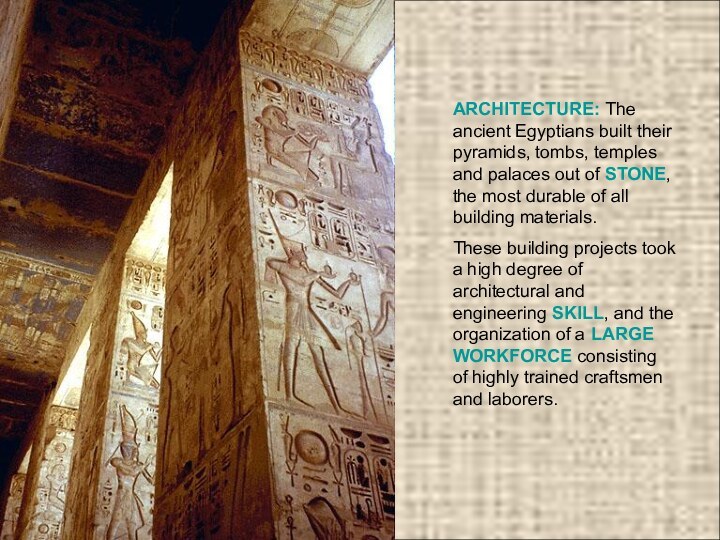
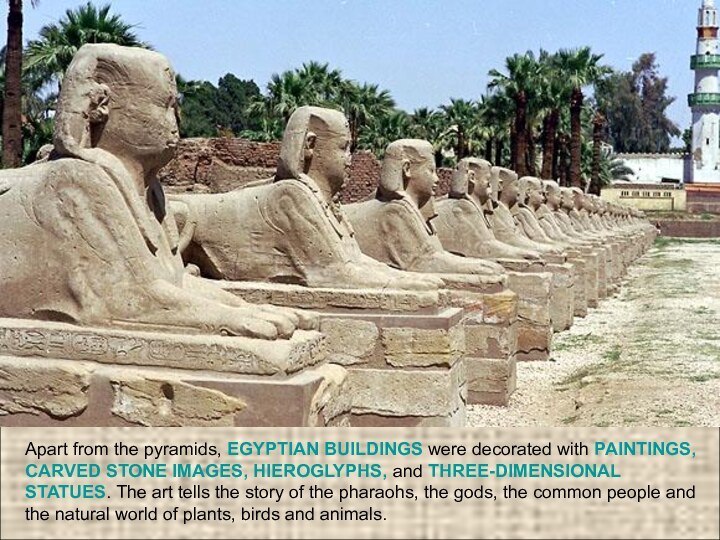


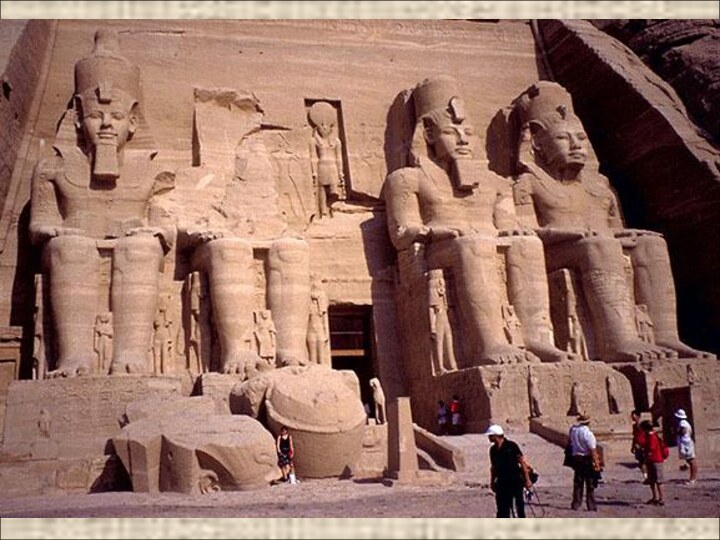



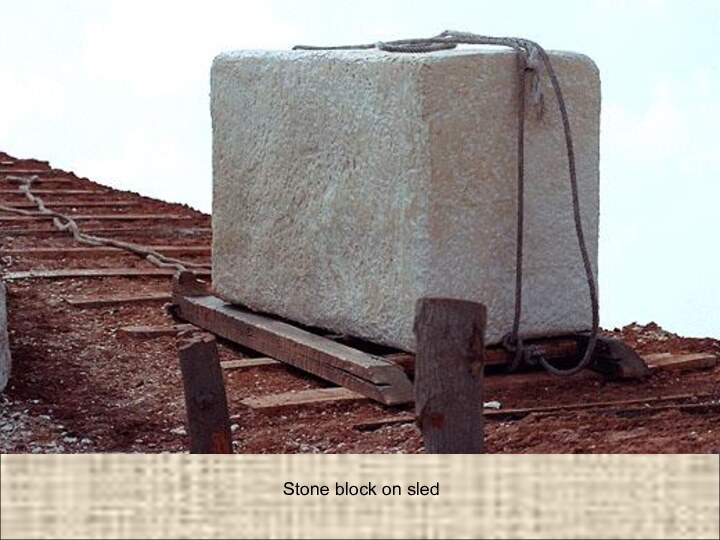
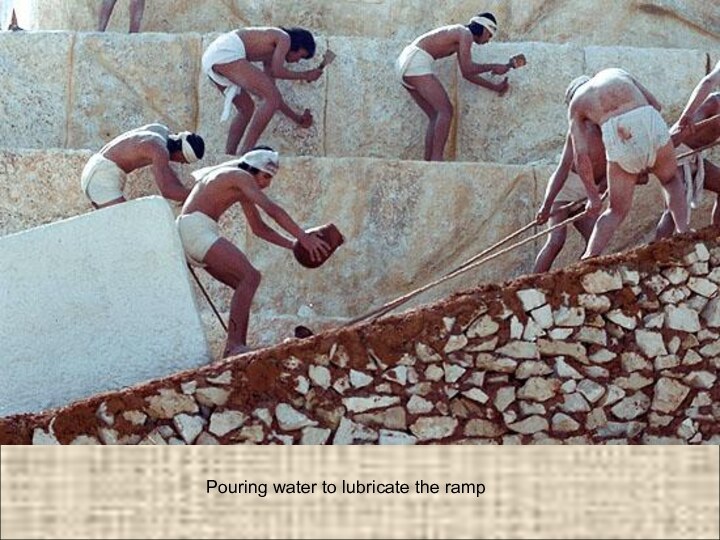

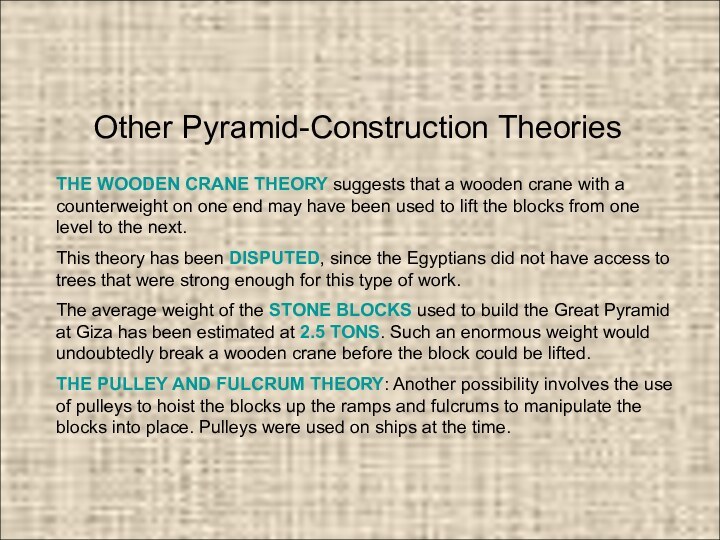
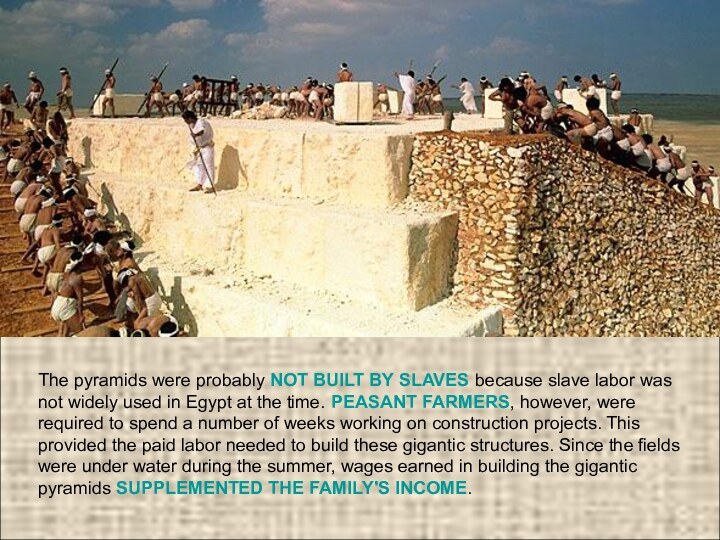
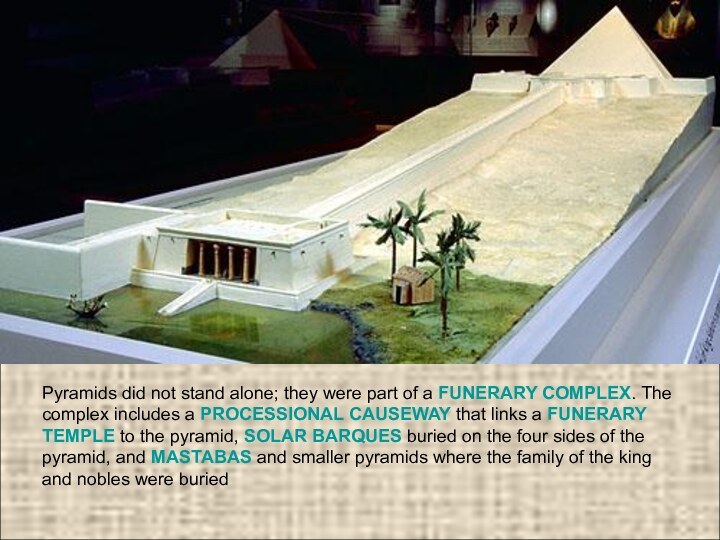


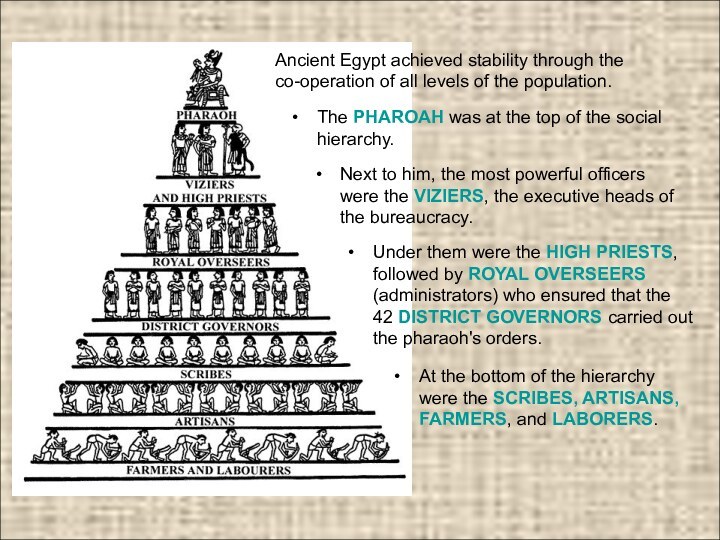
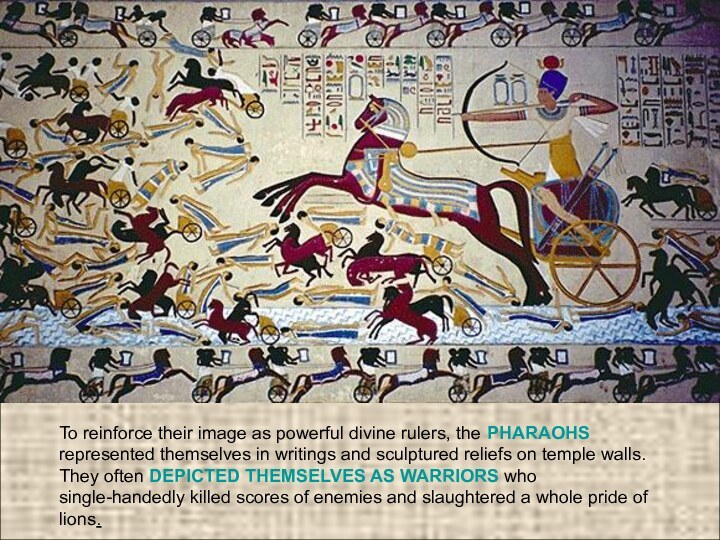




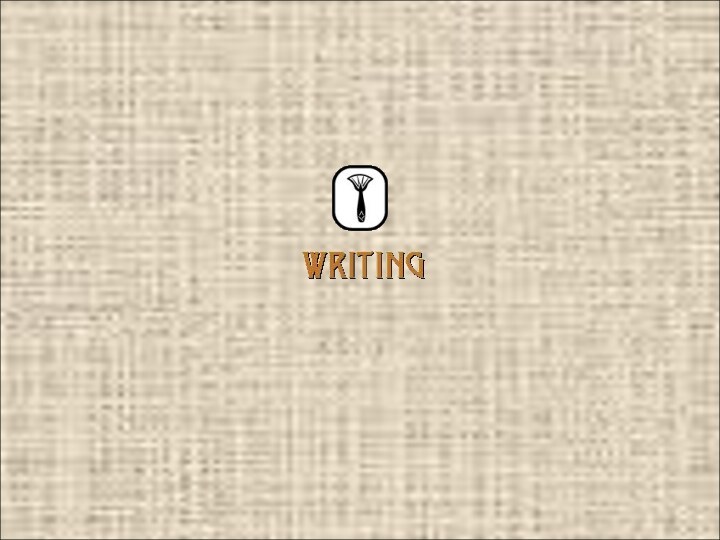


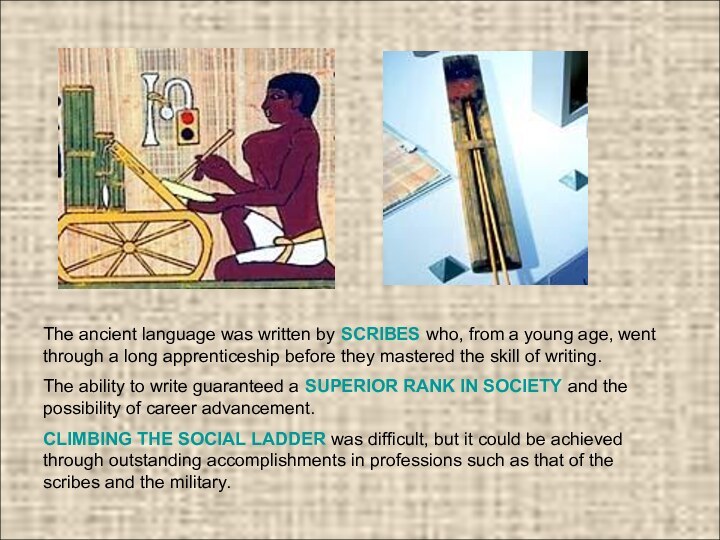
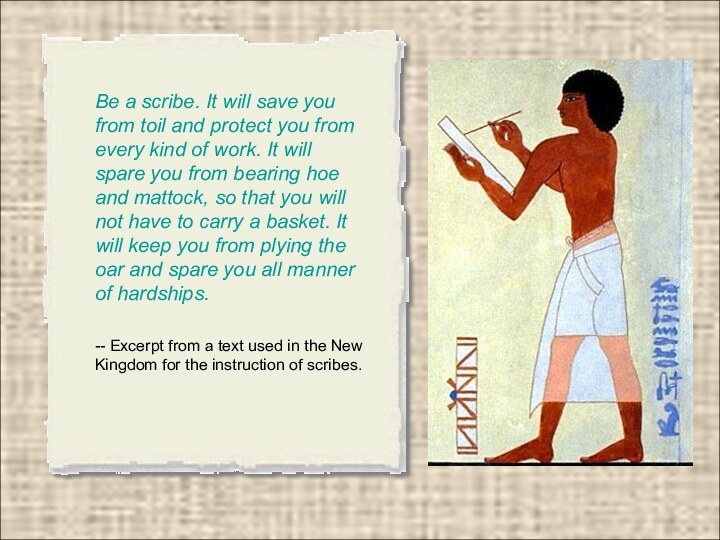
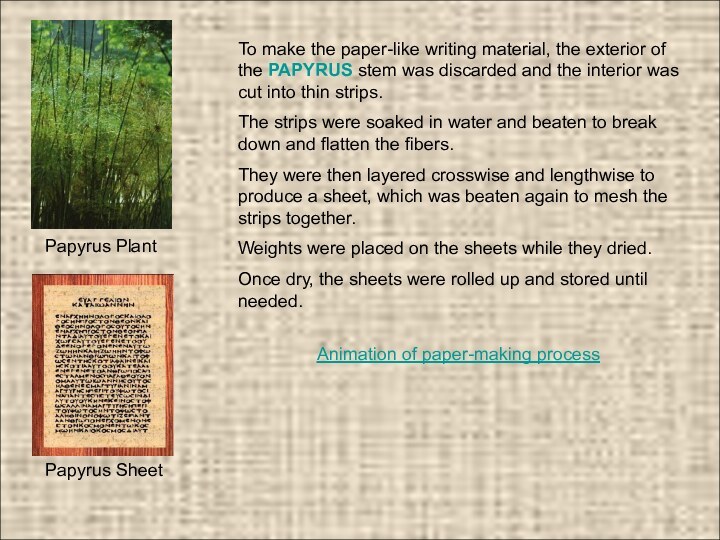

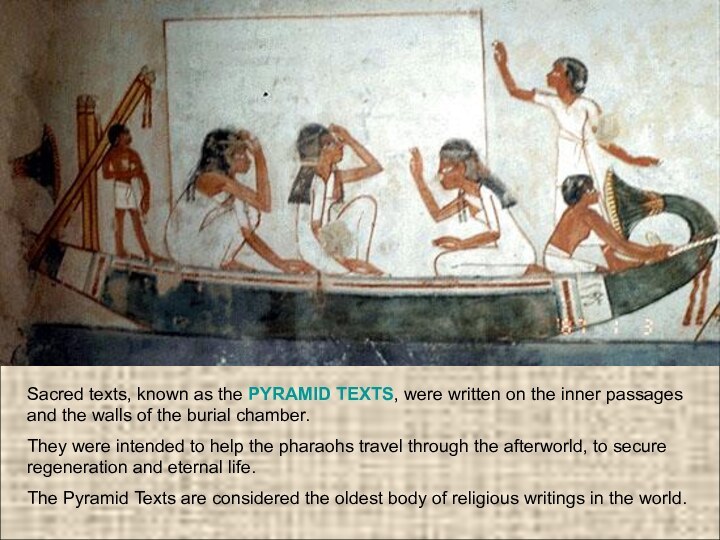
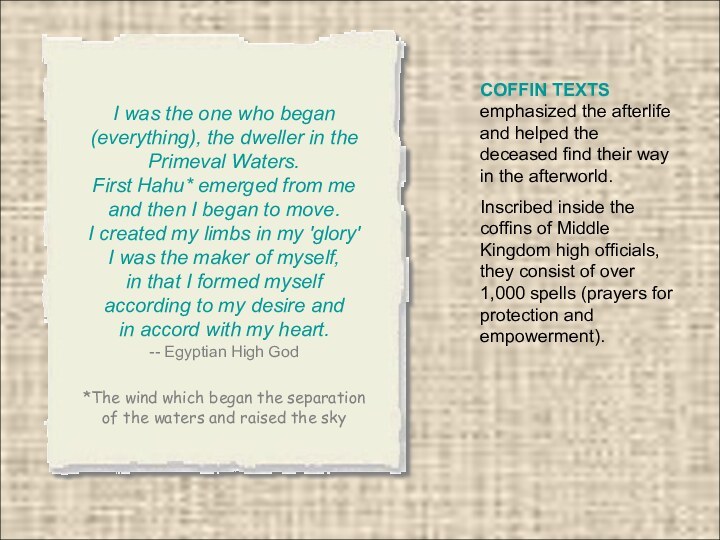
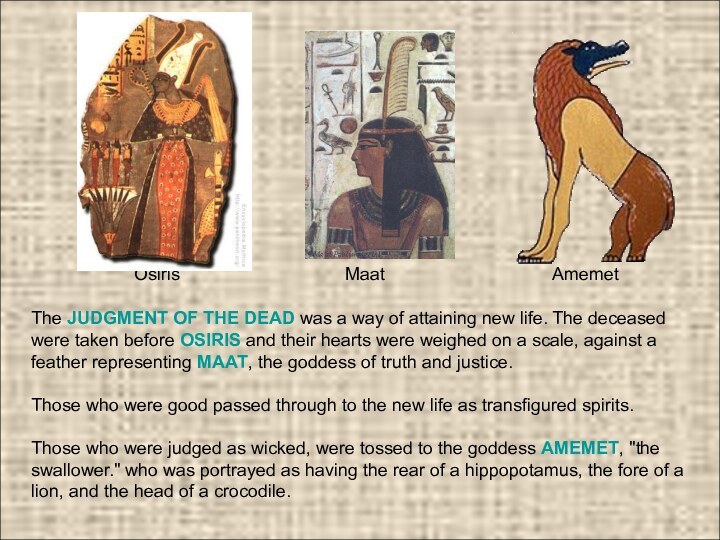

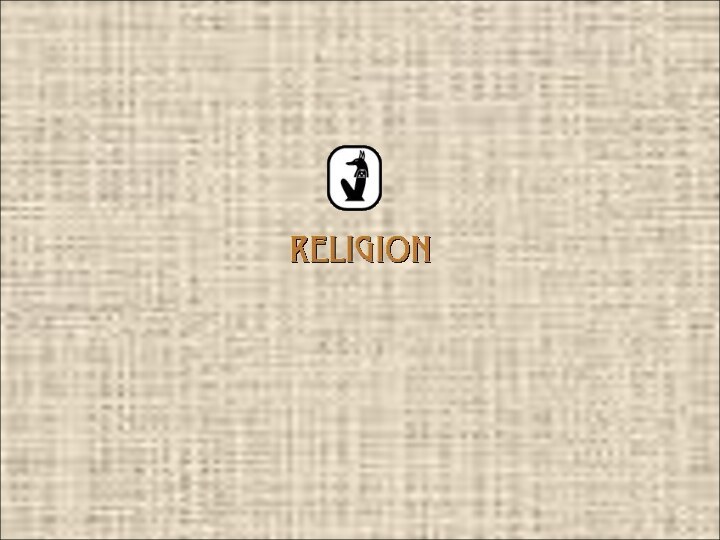


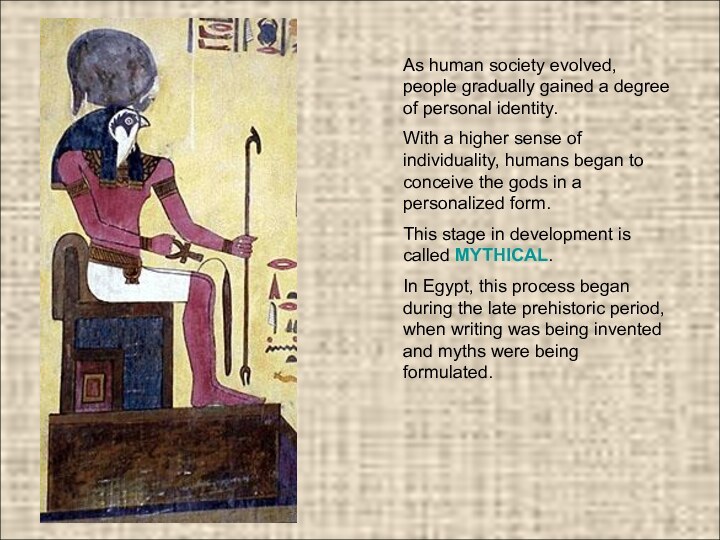
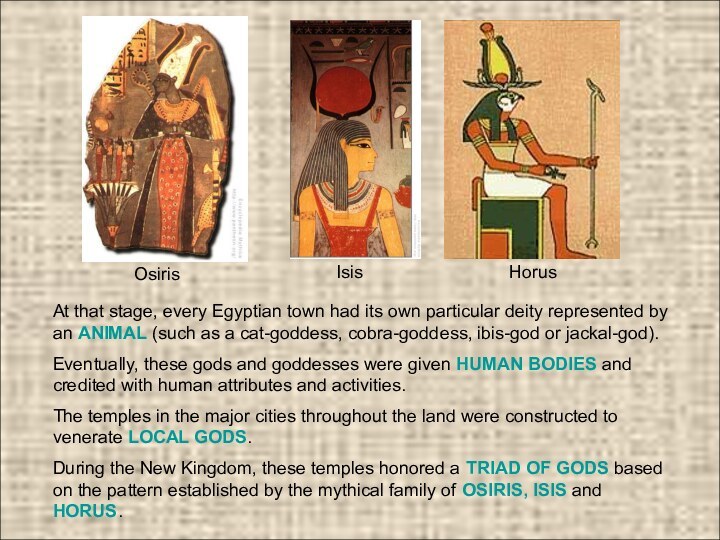

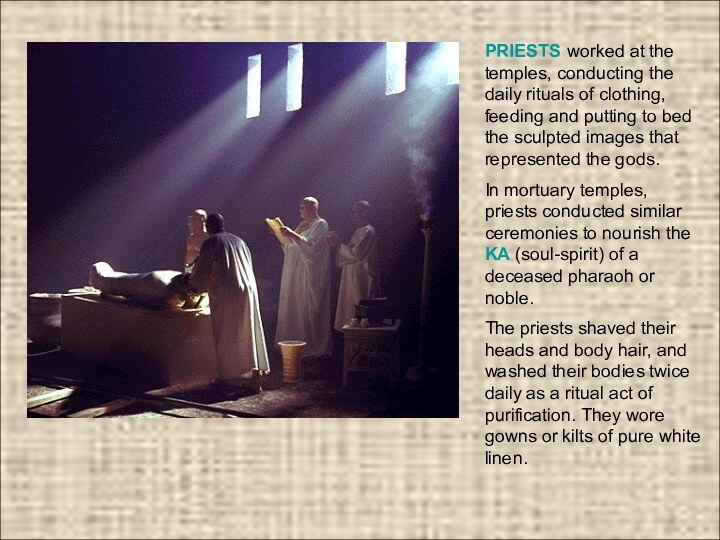
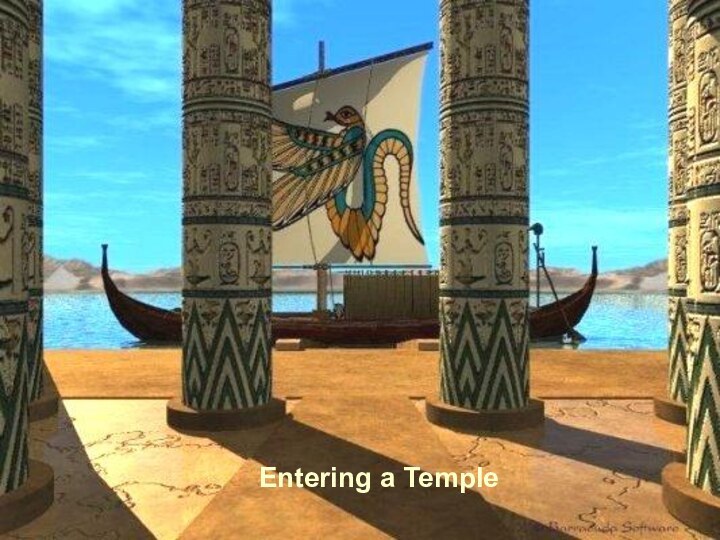
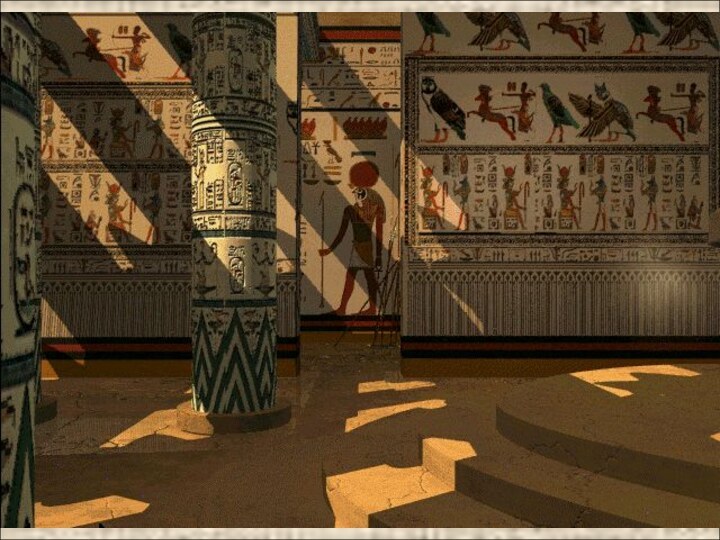

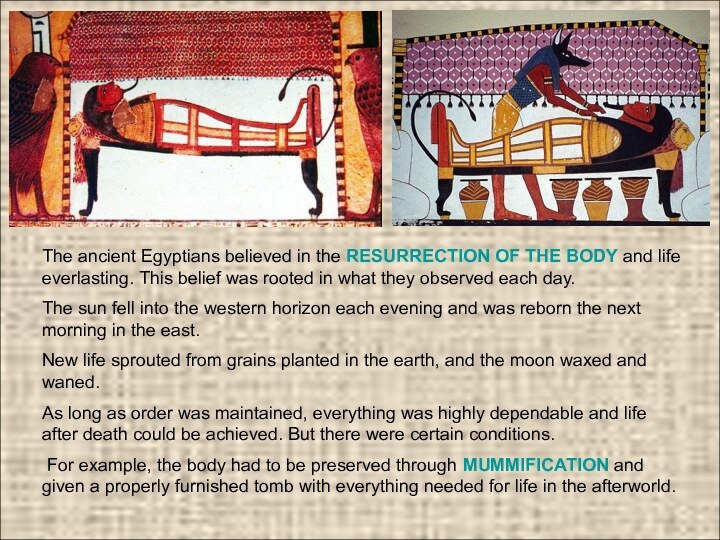

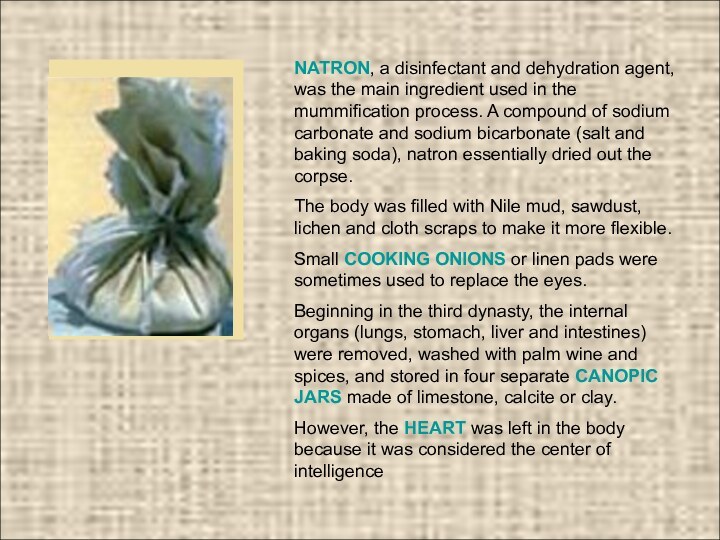

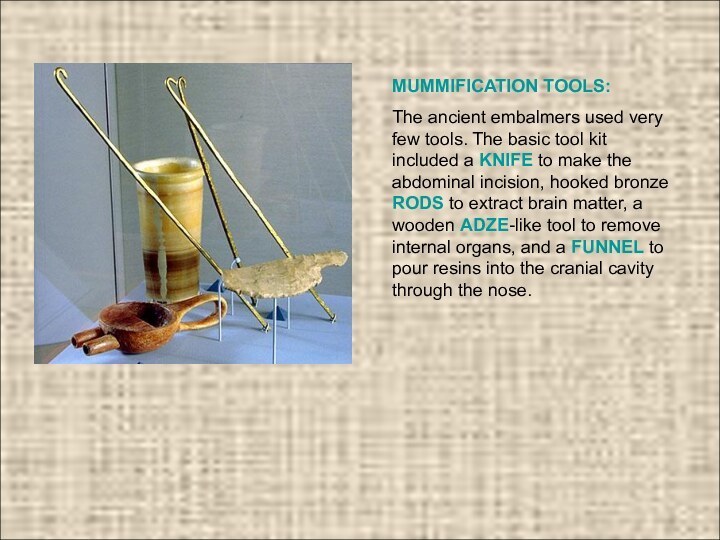



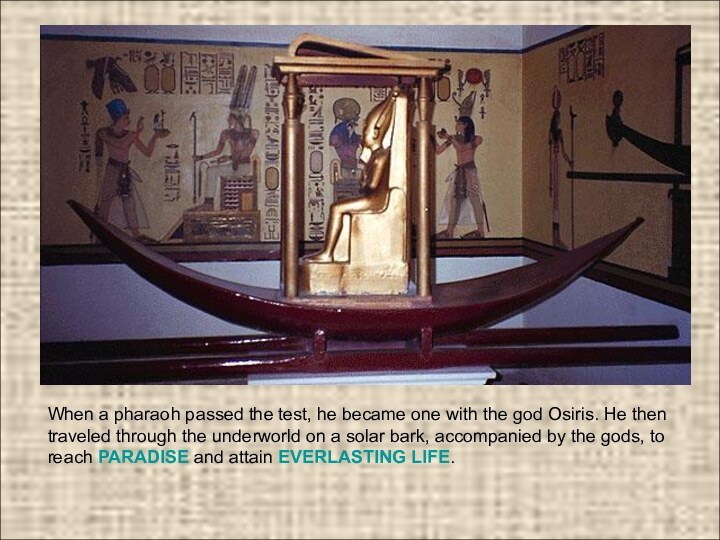
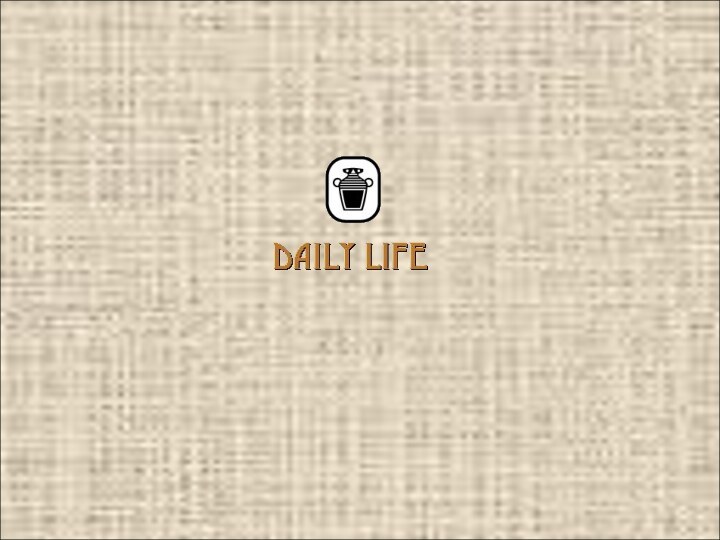


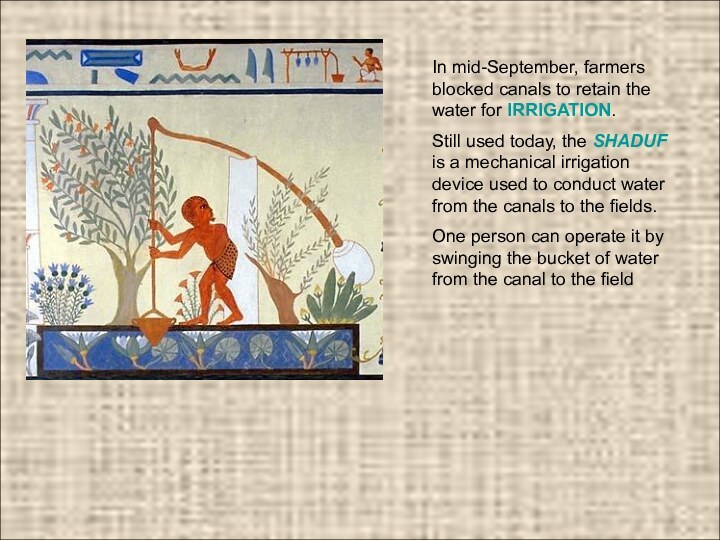
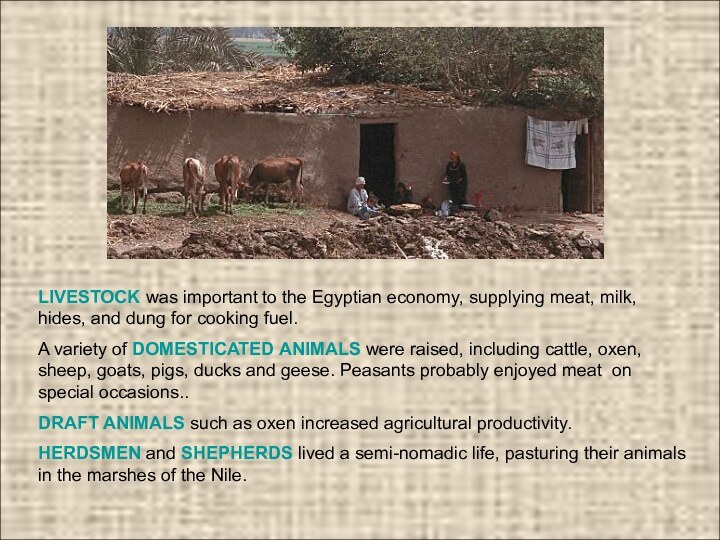

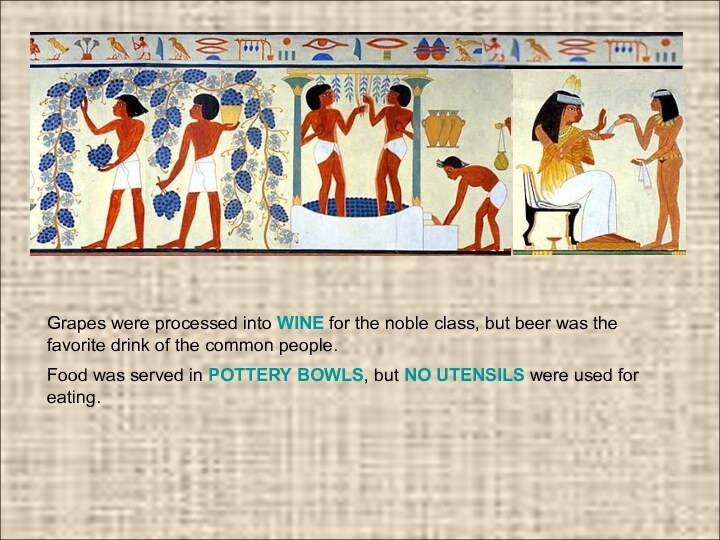






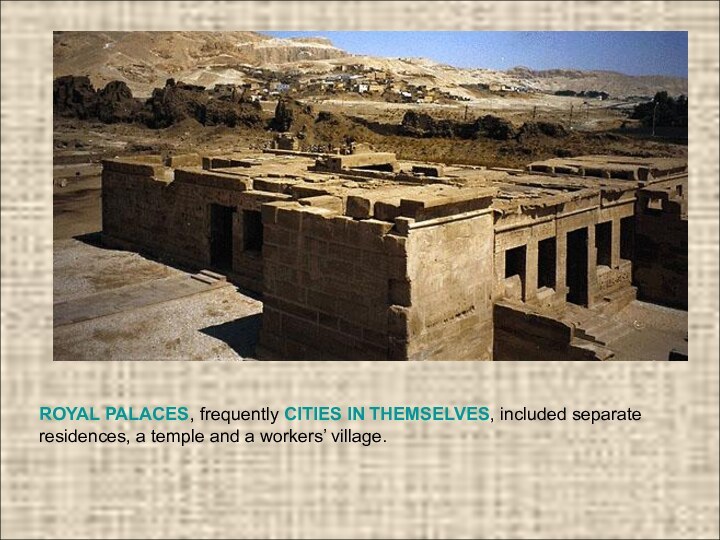

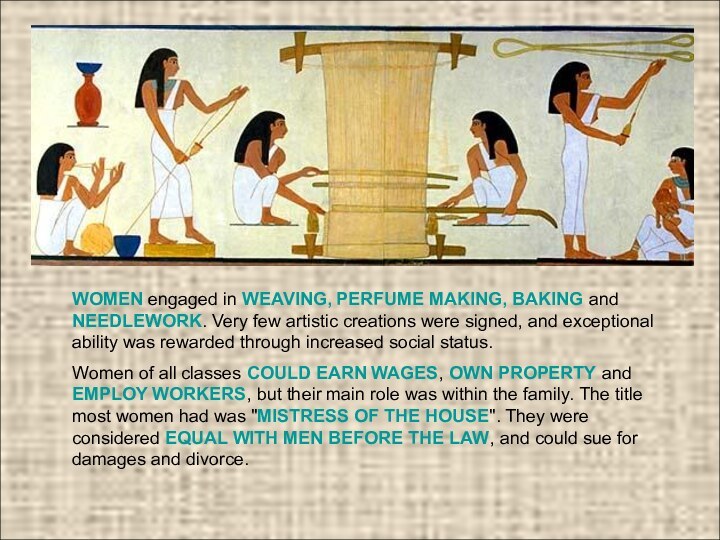


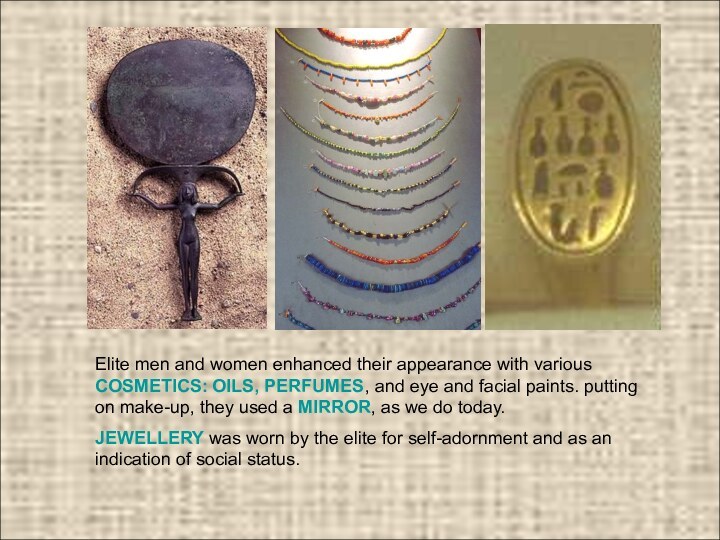
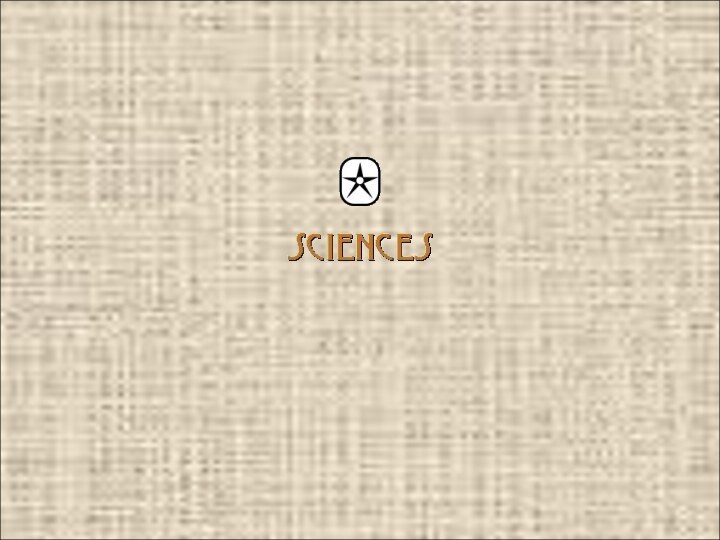




Слайд 4 Bounded on the south, east and west by
an impenetrable desert, and on the north by the
sea,ANCIENT EGYPT was protected from outside influences, which allowed it to evolve in its own unique way.
Слайд 5 For centuries, THE NILE RIVER FLOODED THE VALLEY,
enriching the land with a thick layer of alluvial
soil. Flooding occurred from July to September as the result of the tropical rains in the Ethiopian tableland. The river attained its highest level in October, then began to recede to its lowest point sometime between April and June.Слайд 6 TRANSPORTATION: The Nile River was the highway that
joined the country together. Up until the nineteenth century,
travel by land was virtually unknown.Слайд 7 DUALITIES, such as desert and river valley, Upper
and Lower Egypt, life and death, were an important
organizing principle of the Egyptian’s world view.Слайд 9 ARCHITECTURE: The ancient Egyptians built their pyramids, tombs,
temples and palaces out of STONE, the most durable
of all building materials.These building projects took a high degree of architectural and engineering SKILL, and the organization of a LARGE WORKFORCE consisting of highly trained craftsmen and laborers.
Слайд 10 Apart from the pyramids, EGYPTIAN BUILDINGS were decorated
with PAINTINGS, CARVED STONE IMAGES, HIEROGLYPHS, and THREE-DIMENSIONAL STATUES.
The art tells the story of the pharaohs, the gods, the common people and the natural world of plants, birds and animals.Слайд 14 One of the oldest mysteries surrounding ancient Egypt
concerns the building of the PYRAMIDS. How did humans
move such massive blocks of stone using only Stone Age tools? The Egyptians left thousands of illustrations depicting daily life in the Old Kingdom. Curiously enough, none of them show how pyramids were built.SEVERAL THEORIES attempt to explain how pyramids were constructed, but for now, the mystery has yet to be solved.
Слайд 15 One theory suggests that RAMPS were used to
haul the stone blocks on wooden sleds up the
side of the pyramids. The ramps were lubricated with water to reduce friction when hauling the blocks. As few as 10 men were needed to drag a stone block up a ramp. may have been several ramps on each side of the pyramid at different levels, and a ramp may have been coiled around the pyramid as it grew in height. Once a stone block reached its desired level, wooden rockers may have been used to maneuver it into position.The Ramp Theory
Слайд 20 THE WOODEN CRANE THEORY suggests that a wooden
crane with a counterweight on one end may have
been used to lift the blocks from one level to the next.This theory has been DISPUTED, since the Egyptians did not have access to trees that were strong enough for this type of work.
The average weight of the STONE BLOCKS used to build the Great Pyramid at Giza has been estimated at 2.5 TONS. Such an enormous weight would undoubtedly break a wooden crane before the block could be lifted.
THE PULLEY AND FULCRUM THEORY: Another possibility involves the use of pulleys to hoist the blocks up the ramps and fulcrums to manipulate the blocks into place. Pulleys were used on ships at the time.
Other Pyramid-Construction Theories
Слайд 21 The pyramids were probably NOT BUILT BY SLAVES
because slave labor was not widely used in Egypt
at the time. PEASANT FARMERS, however, were required to spend a number of weeks working on construction projects. This provided the paid labor needed to build these gigantic structures. Since the fields were under water during the summer, wages earned in building the gigantic pyramids SUPPLEMENTED THE FAMILY'S INCOME.Слайд 22 Pyramids did not stand alone; they were part
of a FUNERARY COMPLEX. The complex includes a PROCESSIONAL
CAUSEWAY that links a FUNERARY TEMPLE to the pyramid, SOLAR BARQUES buried on the four sides of the pyramid, and MASTABAS and smaller pyramids where the family of the king and nobles were buriedСлайд 24 GOVERNMENT and RELIGION were inseparable in ancient Egypt.
The PHARAOH was the head of State and the
divine representative of the gods on earth.Religion and government brought order to society through:
The construction of TEMPLES
The creation of LAWS
TAXATION
The ORGANIZATION OF LABOR
TRADE with neighbors
The DEFENCE of the country’s interests.
Слайд 25 The PHAROAH was at the top of the
social hierarchy.
Ancient Egypt achieved stability through the co-operation
of all levels of the population.Under them were the HIGH PRIESTS, followed by ROYAL OVERSEERS (administrators) who ensured that the 42 DISTRICT GOVERNORS carried out the pharaoh's orders.
Next to him, the most powerful officers were the VIZIERS, the executive heads of the bureaucracy.
At the bottom of the hierarchy were the SCRIBES, ARTISANS, FARMERS, and LABORERS.
Слайд 26 To reinforce their image as powerful divine rulers,
the PHARAOHS represented themselves in writings and sculptured reliefs
on temple walls. They often DEPICTED THEMSELVES AS WARRIORS who single-handedly killed scores of enemies and slaughtered a whole pride of lions.Слайд 27 Not all the pharaohs were men. Before the
Graeco-Roman period, at least three WOMEN ascended the throne,
the most important being Queen HATSHEPSUT.Слайд 28 ROYAL WOMEN: Royal mothers, wives, and daughters derived
their status from their relationship with the king.
Kings
had MANY WIVES and royal families were large. The most prolific was Rameses II, who had eight wives and over a hundred children.
To keep the royal bloodline pure, kings often MARRIED within their family, a SISTER or half sister, for example.
In a few cases, they married their DAUGHTERS, although it is not clear whether or not these marriages were true conjugal unions.
Слайд 29 Next to pharaoh, the most powerful officer in
the hierarchy was the VIZIER, the EXECUTIVE HEAD of
the bureaucracy.The position of vizier was filled by a prince or a person of exceptional ability. His title is translated as "superintendent of all works of the king.“
As the SUPREME JUDGE of the state, the vizier ruled on all petitions and grievances brought to the court.
All ROYAL COMMANDS passed through his hands before being transmitted to the scribes in his office.
They in turn dispatched orders to the heads of distant towns and villages, and dictated the rules and regulations related to the collection of taxes.
Слайд 30 The ancient Egyptians remained very conscious of SOCIAL
STRATIFICATION, and barriers between the classes were quite rigid.
Climbing
the social ladder was difficult, but it could be achieved through outstanding accomplishments in professions such as that of the scribes and the MILITARY.The military took part in WARFARE and TRADE missions, helping to maintain Egypt's sovereignty and expand its territories.
Слайд 32 The EGYPTIAN LANGUAGE was one of the earliest
languages to be written down, perhaps only the Sumerian
language is older.First appearing on stone and pottery dating from 3100 B.C. to 3000 B.C., it remained in use for almost 3,000 years.
The last inscription was written in A.D. 394.
Слайд 33 The word HIEROGLYPH literally means "sacred carvings". The
Egyptians first used hieroglyphs for inscriptions carved or painted
on temple walls.This form of PICTORIAL WRITING was also used on:
Tombs
Sheets of papyrus
Wooden boards covered with a stucco wash
Potsherds
Fragments of limestone.
Слайд 34
The ancient language was written by SCRIBES who,
from a young age, went through a long apprenticeship
before they mastered the skill of writing.The ability to write guaranteed a SUPERIOR RANK IN SOCIETY and the possibility of career advancement.
CLIMBING THE SOCIAL LADDER was difficult, but it could be achieved through outstanding accomplishments in professions such as that of the scribes and the military.
Слайд 35 Be a scribe. It will save you from
toil and protect you from every kind of work.
It will spare you from bearing hoe and mattock, so that you will not have to carry a basket. It will keep you from plying the oar and spare you all manner of hardships.-- Excerpt from a text used in the New Kingdom for the instruction of scribes.
Слайд 36
Papyrus Plant
Papyrus Sheet
Animation of paper-making process
To make the
paper-like writing material, the exterior of the PAPYRUS stem
was discarded and the interior was cut into thin strips.The strips were soaked in water and beaten to break down and flatten the fibers.
They were then layered crosswise and lengthwise to produce a sheet, which was beaten again to mesh the strips together.
Weights were placed on the sheets while they dried.
Once dry, the sheets were rolled up and stored until needed.
Слайд 37
DRAFTSMEN were scribes who specialized in drawing.
They followed
a formula that makes standing and sitting figures look
stiff.Using a traditional grid of 18 squares, they sketched figures according to a predetermined pattern, making no attempt to show perspective.
The eyes and shoulders are drawn from the front and the face, torso, arms and legs
Слайд 38 Sacred texts, known as the PYRAMID TEXTS, were
written on the inner passages and the walls of
the burial chamber.They were intended to help the pharaohs travel through the afterworld, to secure regeneration and eternal life.
The Pyramid Texts are considered the oldest body of religious writings in the world.
Слайд 39 COFFIN TEXTS emphasized the afterlife and helped the
deceased find their way in the afterworld.
Inscribed inside
the coffins of Middle Kingdom high officials, they consist of over 1,000 spells (prayers for protection and empowerment).
I was the one who began (everything), the dweller in the
Primeval Waters.
First Hahu* emerged from me
and then I began to move.
I created my limbs in my 'glory'
I was the maker of myself,
in that I formed myself
according to my desire and
in accord with my heart.
-- Egyptian High God
*The wind which began the separation
of the waters and raised the sky
Слайд 40 The JUDGMENT OF THE DEAD was a way
of attaining new life. The deceased were taken before
OSIRIS and their hearts were weighed on a scale, against a feather representing MAAT, the goddess of truth and justice.Those who were good passed through to the new life as transfigured spirits.
Those who were judged as wicked, were tossed to the goddess AMEMET, "the swallower." who was portrayed as having the rear of a hippopotamus, the fore of a lion, and the head of a crocodile.
Osiris
Maat
Amemet
Слайд 41 The BOOK OF THE DEAD contains approximately 190
chapters of spells to assist the deceased on their
voyage to eternity.Texts were originally written on papyrus and placed near the dead.
One spell was inscribed on a heart scarab –an amulet placed over the heart either within the mummy's bandages or inside the body.
Later, the spells were written on strips of linen that were wrapped around the mummies.
Слайд 43 RELIGION is the glue that binds local communities
together and transforms them into nations. It creates common
understandings and shared values that are essential to the growth of a civilization.
Слайд 44
By looking at ancient Egypt, one can see
how belief systems evolved.
In the early stages of
human thought, the concept of God did not exist. Our early ancestors were concerned about natural phenomena and the powers that controlled these phenomena.
They did not worship a personalized form of God.
This stage of religious development is referred to as MAGICAL.
Before the concept of God existed, magical power was encapsulated in the hieroglyph of a SCEPTER (or rod or staff).
Слайд 45 As human society evolved, people gradually gained a
degree of personal identity.
With a higher sense of
individuality, humans began to conceive the gods in a personalized form. This stage in development is called MYTHICAL.
In Egypt, this process began during the late prehistoric period, when writing was being invented and myths were being formulated.
Слайд 46 At that stage, every Egyptian town had its
own particular deity represented by an ANIMAL (such as
a cat-goddess, cobra-goddess, ibis-god or jackal-god).Eventually, these gods and goddesses were given HUMAN BODIES and credited with human attributes and activities.
The temples in the major cities throughout the land were constructed to venerate LOCAL GODS.
During the New Kingdom, these temples honored a TRIAD OF GODS based on the pattern established by the mythical family of OSIRIS, ISIS and HORUS.
Osiris
Isis
Horus
Слайд 47 Like all religions, that of ancient Egypt was
COMPLEX. It evolved over the centuries from one that
emphasized local deities into a national religion with a smaller number of principal deities.Some theologians think that Egypt was moving towards a monotheistic faith in a single creator, symbolized by the SUN GOD.
There was no single belief system, but the Egyptians shared a common understanding about the CREATION OF THE WORLD and the possibility of REVERTING TO CHAOS if the destructive forces of the universe were unleashed.
Слайд 48 PRIESTS worked at the temples, conducting the daily
rituals of clothing, feeding and putting to bed the
sculpted images that represented the gods.In mortuary temples, priests conducted similar ceremonies to nourish the KA (soul-spirit) of a deceased pharaoh or noble.
The priests shaved their heads and body hair, and washed their bodies twice daily as a ritual act of purification. They wore gowns or kilts of pure white linen.
Слайд 52 The ancient Egyptians believed in the RESURRECTION OF
THE BODY and life everlasting. This belief was rooted
in what they observed each day.The sun fell into the western horizon each evening and was reborn the next morning in the east.
New life sprouted from grains planted in the earth, and the moon waxed and waned.
As long as order was maintained, everything was highly dependable and life after death could be achieved. But there were certain conditions.
For example, the body had to be preserved through MUMMIFICATION and given a properly furnished tomb with everything needed for life in the afterworld.
Слайд 53 Around 450 B.C., the Greek historian HERODOTUS documented
the art of MUMMIFICATION.
As much of the brain as
it is possible is extracted through the nostrils with an iron hook, and what the hook cannot reach is dissolved with drugs. Next, the flank is slit open . . . and the entire contents of the abdomen removed. The cavity is then thoroughly cleansed and washed out . . . Then it is filled with pure crushed myrrh, cassia, and all other aromatic substances, except frankincense. [The incision] is sewn up, and then the body is placed in natron, covered entirely for 70 days, never longer. When this period . . . is ended, the body is washed and then wrapped from the head to the feet in linen which has been cut into strips and smeared on the underside with gum which is commonly used by the Egyptians in the place of glue. -- HerodotusСлайд 54 NATRON, a disinfectant and dehydration agent, was the
main ingredient used in the mummification process. A compound
of sodium carbonate and sodium bicarbonate (salt and baking soda), natron essentially dried out the corpse.The body was filled with Nile mud, sawdust, lichen and cloth scraps to make it more flexible.
Small COOKING ONIONS or linen pads were sometimes used to replace the eyes.
Beginning in the third dynasty, the internal organs (lungs, stomach, liver and intestines) were removed, washed with palm wine and spices, and stored in four separate CANOPIC JARS made of limestone, calcite or clay.
However, the HEART was left in the body because it was considered the center of intelligence
Слайд 55
MATERIALS USED IN MUMMIFICATION:
Linen
Sawdust
Lichen
Beeswax
Resin
Frankincense
Natron
Onion
Nile mud
Linen pads
Слайд 56
MUMMIFICATION TOOLS:
The ancient embalmers used very few tools.
The basic tool kit included a KNIFE to make
the abdominal incision, hooked bronze RODS to extract brain matter, a wooden ADZE-like tool to remove internal organs, and a FUNNEL to pour resins into the cranial cavity through the nose.Слайд 57 There are three elements to the Egyptian CONCEPT
OF SOUL:
KA is the life force or spiritual
double of the person.
BA is represented as a human-headed bird that leaves the body when a person dies. The face of Ba was the exact likeness of that of the deceased person.
AKH is the spirit of Re (represent-ing light), the transfigured spirit of a person that becomes one with light after death.
Слайд 58
The journey to the afterworld was considered full
of danger. Traveling on a SOLAR BARK, the mummy
passed through the underworld, which was inhabited by serpents armed with long knives, fire-spitting dragons and reptiles with five ravenous heads. Upon arriving in the realm of the LAND OF THE GODS, the deceased had to pass through seven gates, reciting accurately a magic spell at each stop. If successful, they arrived at the HALL OF OSIRIS, the place of judgment.Слайд 59 Here the gods of the dead performed the
WEIGHING OF THE HEART ceremony to judge whether the
person's earthly deeds were virtuous.The person’s heart was placed on a scale, counterbalanced by a feather that represented Maat, the goddess of truth and justice.
If the heart was equal in weight to the feather, the person was justified and achieved immortality. If not, it was devoured by the goddess Amemet. This meant that the person would not survive in the afterlife.
Слайд 60 When a pharaoh passed the test, he became
one with the god Osiris. He then traveled through
the underworld on a solar bark, accompanied by the gods, to reach PARADISE and attain EVERLASTING LIFE.Слайд 62 The flooding of the Nile rendered the narrow
strip of land on either side of the river
extremely fertile. INTENSIVE AGRICULTURE was practiced by the majority of the peasant population. who played a vital role within the country's STRICT HIERARHICAL SOCIETY. As the flood waters receded, SOWING and PLOWING began, using primitive wooden plows.In addition to such GRAINS as barley and emmer (a coarse wheat), a large variety of VEGETABLES were grown, including onions, garlic, leeks, beans, lentils, peas, radishes, cabbage, cucumbers, and lettuce. There were also FRUITS such as dates, figs, pomegranates, melons and grapes,
The abundance of flowers provided nectar for the bees to produce HONEY, which the Egyptians processed. FLAX was grown for making linen, and PAPYRUS was harvested to be converted into paper, ropes, mats, sandals and light skiffs.
Слайд 63
Breaking the ground
with plow and hoe
Reaping
and
scattering the seed
Separating the grain
from the
chaff Although the land was worked by the PEASANTS, it was owned by the king, his officials and the temples. Farmers had to meet GRAIN QUOTAS, which were handed over to the owners as a form of taxation.
They were allowed to keep a portion of the crops for their own benefit. If they did not produce the quantity expected, however, they were severely punished.
Слайд 64 In mid-September, farmers blocked canals to retain the
water for IRRIGATION.
Still used today, the SHADUF is
a mechanical irrigation device used to conduct water from the canals to the fields. One person can operate it by swinging the bucket of water from the canal to the field
Слайд 65 LIVESTOCK was important to the Egyptian economy, supplying
meat, milk, hides, and dung for cooking fuel.
A
variety of DOMESTICATED ANIMALS were raised, including cattle, oxen, sheep, goats, pigs, ducks and geese. Peasants probably enjoyed meat on special occasions.. DRAFT ANIMALS such as oxen increased agricultural productivity.
HERDSMEN and SHEPHERDS lived a semi-nomadic life, pasturing their animals in the marshes of the Nile.
Слайд 66 Barley and emmer, were used to make BEER
and BREAD, the main staples of the Egyptian diet.
Grains were harvested and stored in GRANARIES until ready to be processed.The quantities harvested each season far exceeded the needs of the country, so much was exported to neighbouring countries, providing a rich source of INCOME for the Egyptian treasury
Слайд 67 Grapes were processed into WINE for the noble
class, but beer was the favorite drink of the
common people.Food was served in POTTERY BOWLS, but NO UTENSILS were used for eating.
Слайд 68 Pharaohs and nobles participated in HUNTING, FISHING and
FOWLING expeditions, a means of recreation that had ritualistic
and religious significance.HUNTING SCENES often depicted on temple walls and tombs reinforce the prowess of kings and nobles. Rabbits, deer, gazelles, bulls, oryx, antelopes, hippopotamuses, elephants and lions were among the wild animals hunted for their meat and skins.
Слайд 69 FISHING allowed the working class to add variety
to its diet. The poor substituted fish for meat,
which they could not afford. The Nile, the marshes of the delta and the Mediterranean Sea offered them a rich variety of species.FISHING METHODS included the use of a hook and line, harpoons, traps and nets.
BIRDS, including geese and ducks, were also HUNTED in the marshes and papyrus thickets along the Nile.
Small fishing boats called SKIFFS were made from PAPYRUS REEDS, which are naturally filled with air pockets, making them particularly buoyant. Skiffs were also used for hunting game in the Nile marshes.
Слайд 70 Most HOUSES were made of BRICK. The banks
of the Nile provided the mud used to make
bricks.Brick makers collected MUD, added STRAW and WATER to it as needed, and stomped it with their feet until it reached the right consistency. The mixture was then placed in a MOLD. Once shaped, the bricks were removed from the mould and left on the ground to dry in the sun.
Egyptian PEASANTS would have lived in SIMPLE MUD-BRICK HOMES containing only a few pieces of furniture: BEDS, STOOLS, BOXES and LOW TABLES.
Слайд 71 CRAFTWORKERS lived in one- or two-storey FLAT-ROOFED DWELLINGS
made of mud bricks. The walls and roof would
have been covered with plaster and painted.Inside, there was a RECEPTION ROOM, a LIVING ROOM, BEDROOMS and a CELLAR in which food and beverages were stored. Food was prepared in an OUTDOOR KITCHEN equipped with a mud-brick oven. Stairs on the exterior of the house led to a ROOF-TOP TERRACE.
Слайд 72 The HOMES OF THE WEALTHY were larger and
more luxurious.
SPACIOUS reception and living rooms opened onto
a CENTRAL GARDEN COURTYARD with a fish pond and flowering plants. Each bedroom had a PRIVATE BATHROOM, and the walls, columns and ceilings were painted with BEAUTIFUL DESIGNS inspired by nature.
Elaborate and highly DECORATED FURNITURE included beds, chairs, boxes and tables.
PAINTED CLAY POTS and vessels, as well as ALABASTER BOWLS AND JARS, were also found in the homes of the nobles.
Слайд 74 ROYAL PALACES, frequently CITIES IN THEMSELVES, included separate
residences, a temple and a workers’ village.
Слайд 75 SKILLED ARTISANS were considered SOCIALLY SUPERIOR to common
laborers. They learned their art from a master who
ensured stylistic continuity in the beautiful objects they created for the living and the dead.Skilled CARPENTERS manufactured a wide range of products, from roofing beams to furniture and statues. Their tools included saws, axes, chisels, adzes, wooden mallets, stone polishers and bow drills.
Other artisans included STONE MAKERS and SCULPTORS, BEAD MAKERS, BRICK LAYERS, and POTTERS.
Слайд 76 WOMEN engaged in WEAVING, PERFUME MAKING, BAKING and
NEEDLEWORK. Very few artistic creations were signed, and exceptional
ability was rewarded through increased social status.Women of all classes COULD EARN WAGES, OWN PROPERTY and EMPLOY WORKERS, but their main role was within the family. The title most women had was "MISTRESS OF THE HOUSE". They were considered EQUAL WITH MEN BEFORE THE LAW, and could sue for damages and divorce.
Слайд 77 FLAX grown by farmers was woven into fine
linen for clothing. WORKING-CLASS MEN wore loincloths or short
kilts, as well as long shirt-like garments tied with a sash at the waist.WEALTHY MEN wore knee-length shirts, loincloths or kilts and adorned themselves with jewellery – a string of beads, armlets and bracelets.
WORKING-CLASS WOMEN wore full-length wraparound gowns and close-fitting sheaths.
ELITE WOMEN enhanced their appearance with make-up, earrings, bracelets and necklaces.
Both men and women wore SANDALS made of papyrus or went barefoot.
Слайд 78 The Egyptian ELITE HIRED HAIRDRESSERS and took great
care of their hair. Hair was WASHED and SCENTED,
and sometimes LIGHTENED WITH HENNA.CHILDREN had their HEADS SHAVED, except for one or two tresses at the side of the head, called a SIDELOCK.
Both men and women sometimes wore HAIRPIECES or WIGS made of human hair,.
Слайд 79 Elite men and women enhanced their appearance with
various COSMETICS: OILS, PERFUMES, and eye and facial paints.
putting on make-up, they used a MIRROR, as we do today.JEWELLERY was worn by the elite for self-adornment and as an indication of social status.
Слайд 81 MATHEMATICS: Although the Egyptians lacked the symbol for
zero, they calculated numbers based on the DECIMAL and
the repetitive (numbers based on the POWER OF 10). The following signs were used to represent numbers in the decimal systemNumbers were usually written LEFT TO RIGHT, starting with the highest denominator. For example, in the number 2,525 the first number to appear on the left would be 2000, then 500, 20 and 5, as follows:
The Egyptians did not develop abstract mathematical formulas. They used the simple arithmetic of ADDITION AND SUBTRACTION
Слайд 82 ASTRONOMY: Like many ancient peoples, the Egyptians studied
the night sky, taking measurements from the stars to
accurately align their pyramids and sun temples with the earth’s four cardinal points. Using an instrument called a MERKHET (similar to an astrolabe), astronomer-priests marked out the foundations of buildings with astonishing accuracy.The GREAT PYRAMID AT GIZA provides an example. This remarkable building has a footprint of over 13 acres and consists of approximately 6.5 million limestone blocks. Its four sides are accurately aligned to face north, east, south, and west, with an error of less than half a degree. They are also virtually identical in length, with less than a 20 cm (8 inch) variance between one side and another.
Слайд 83 MEDICINE: The doctors of ancient Egypt combined MAGIC
SPELLS with REMEDIES. If a person fell sick, the
illness was thought to be caused by the wrath of the gods or by an evil spirit that had entered the body.Both PRIESTS AND DOCTORS were called upon to heal the sick, combining their powers and skills to fix the problem.
Doctors found cures for many diseases and some of their concepts are still used today. They used CASTOR OIL as laxatives, TANNIC ACID from the acadia tree to heal burns, CORIANDER in a tea for stomach illnesses, and CUMMIN SEEDS on aching or arthritic joints and to calm a cough.
They also made and used TOOLS FOR SURGICAL USE that are similar to the ones that we use today.



